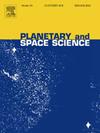Regolith-Based Lunar Habitat for Astronaut Radiation Protection and Organ Dose Assessment.
IF 1.7
4区 物理与天体物理
Q3 ASTRONOMY & ASTROPHYSICS
引用次数: 0
Abstract
Protecting astronauts from radiation is a critical challenge for extended missions on the lunar surface. To mitigate the risks from Galactic Cosmic Rays (GCR) and solar flares, future habitats must be designed with robust shielding against these hazards. Utilizing lunar regolith presents a promising solution, offering effective radiation protection to avoid transporting heavy, prefabricated materials. In this work, we simulated a two-layer lunar dome made of a thin aluminum-based alloy as an inner layer and an outer layer made of lunar regolith. Combined with an advanced mesh-type computerized human phantom, these simulations give a detailed insight into the radiation exposure of astronauts in such habitats. Using the ICRU (International Commission on Radiation Units) sphere as a simplified human phantom we computed the dose equivalent (DE) as a function of the thickness of the outer layer using the BON2020 GCR model. The simulation was repeated at different thicknesses using the ICRP 145 computerized female human phantom to characterize the impact on individual organs. Our study introduces a novel model giving the DE and effective dose equivalent (EDE) exposure experienced by astronauts within a regolith-made lunar dome under GCR during solar minimum conditions, contingent upon the dome's wall thickness. Our comprehensive analysis reveals a decrease in EDE when stacking regolith until 45 g·cm-2. Until 105 g·cm-2, the production of secondary particles would potentially induce more dose than it would protect. We observe rapid attenuation of heavy ions within 45 g·cm-2 of regolith thickness, while the presence of secondary neutrons produced by the interaction of primary protons and alphas with the regolith increases the impact on radiation exposure. Notably, the EDE behind a shield comprised of only 1.136 g·cm-2 of aluminum measures 291 mSv·y-1 with a body-averaged mean quality factor of 3.3, whereas adding 45 g·cm-2 of regolith reduces this exposure to 213 mSv·y-1 and the quality factor to 2.2. Our investigation identifies the skin, breasts, brain, and surface bones as the organs most affected by radiation exposure, with comparable magnitudes of impact across all organs. These findings also underscore the importance of considering organ-specific effects when assessing radiation hazards in space environments.
基于月球风化层的宇航员辐射防护和器官剂量评估。
保护宇航员免受辐射是在月球表面执行长期任务的关键挑战。为了减轻银河宇宙射线(GCR)和太阳耀斑的风险,未来的栖息地必须设计具有强大的屏蔽这些危害的功能。利用月球风化层提供了一个很有前途的解决方案,提供有效的辐射保护,以避免运输沉重的预制材料。在这项工作中,我们模拟了一个双层月球圆顶,由薄铝基合金制成的内层和由月球风化层制成的外层。结合先进的网格型计算机化人体幻影,这些模拟可以详细了解宇航员在这种栖息地中的辐射暴露情况。使用ICRU(国际辐射单位委员会)球体作为简化的人体幻影,我们使用BON2020 GCR模型计算了剂量当量(DE)作为外层厚度的函数。使用ICRP 145计算机化女性人体幻影在不同厚度上重复模拟,以表征对单个器官的影响。我们的研究引入了一个新的模型,该模型给出了在太阳极小期条件下,宇航员在月球壳中所经历的DE和有效剂量当量(EDE)暴露,这取决于月球壳的壁厚。我们的综合分析表明,当风化层堆积到45 g·cm-2时,EDE下降。在105 g·cm-2之前,二次粒子的产生可能导致的剂量大于其保护的剂量。我们观察到在45 g·cm-2的风化层厚度范围内重离子的快速衰减,而初级质子和α粒子与风化层相互作用产生的次级中子的存在增加了辐射暴露的影响。值得注意的是,仅由1.136 g·cm-2的铝组成的屏蔽后的EDE测量为291 mSv·y-1,身体平均质量因子为3.3,而添加45 g·cm-2的风化层将暴露于213 mSv·y-1,质量因子为2.2。我们的调查确定皮肤、乳房、大脑和表面骨骼是受辐射照射影响最大的器官,所有器官的影响程度相当。这些发现还强调了在评估空间环境中的辐射危害时考虑器官特异性影响的重要性。
本文章由计算机程序翻译,如有差异,请以英文原文为准。
求助全文
约1分钟内获得全文
求助全文
来源期刊

Planetary and Space Science
地学天文-天文与天体物理
CiteScore
5.40
自引率
4.20%
发文量
126
审稿时长
15 weeks
期刊介绍:
Planetary and Space Science publishes original articles as well as short communications (letters). Ground-based and space-borne instrumentation and laboratory simulation of solar system processes are included. The following fields of planetary and solar system research are covered:
• Celestial mechanics, including dynamical evolution of the solar system, gravitational captures and resonances, relativistic effects, tracking and dynamics
• Cosmochemistry and origin, including all aspects of the formation and initial physical and chemical evolution of the solar system
• Terrestrial planets and satellites, including the physics of the interiors, geology and morphology of the surfaces, tectonics, mineralogy and dating
• Outer planets and satellites, including formation and evolution, remote sensing at all wavelengths and in situ measurements
• Planetary atmospheres, including formation and evolution, circulation and meteorology, boundary layers, remote sensing and laboratory simulation
• Planetary magnetospheres and ionospheres, including origin of magnetic fields, magnetospheric plasma and radiation belts, and their interaction with the sun, the solar wind and satellites
• Small bodies, dust and rings, including asteroids, comets and zodiacal light and their interaction with the solar radiation and the solar wind
• Exobiology, including origin of life, detection of planetary ecosystems and pre-biological phenomena in the solar system and laboratory simulations
• Extrasolar systems, including the detection and/or the detectability of exoplanets and planetary systems, their formation and evolution, the physical and chemical properties of the exoplanets
• History of planetary and space research
 求助内容:
求助内容: 应助结果提醒方式:
应助结果提醒方式:


